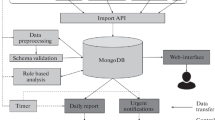Summary
A technique to implement a workload model that must be representative of both static and dynamic characteristics of a workload is presented. The main goal of this work is the construction of a representative and compact artificial workload model. The approach taken is first to assign the set of workload components to classes having homogeneous static (i.e., load-independent) characteristics using clustering and then to model the dynamic sequence of components execution with a suitable stochastic process. The representativeness of such a workload model may be verified applying the physically or the function-oriented criteria for the static aspects and the performance-oriented criterion for the dynamic aspects considered. The results of an experimental application of this technique to model the workload of a university environment are presented.
Similar content being viewed by others
References
Agrawala, A.K., Mohr, J.M., Bryant, R.M.: An approach to the workload characterization problem. Computer 9, 18–32 (1976)
Agrawala, A.K., Mohr, J.M.: A markovian model of a job. Proc. of CPUEG, 119–126 (1978)
Artis, H.P.: Capacity planning for MVS computer systems. In: Performance of Computer Installations (D. Ferrari, ed.), pp. 25–35. Amsterdam: North-Holland 1978
Bolzoni, M.L., Calzarossa, M., Mapelli, P., Serazzi, G.: A package for the implementation of static workload models. Proc. 1982 ACM SIGMETRICS Conf. on Measurement and Modeling of Computer Systems, 58–67 (1982)
Bruell, S.C., Balbo, G.: Computational algorithms for closed queueing networks. Amsterdam: North-Holland 1980
Calzarossa, M., Serazzi, G.: A characterization of the variation in time of workload arrival patterns. IEEE Trans, on Comp. C-24, 156–162 (1985)
Calzarossa, M., Ferrari, D.: Sensitivity study of the clustering approach to workload modeling. Proc. 1985 ACM SIGMETRICS Conf. on Measurement and Modeling of Computer Systems, 38–39 (1985) and, Performance Evaluation 6 (1986) (To appear)
Calzarossa, M., Gelenbe, E., Serazzi, G.: The deterministic flows model: parameter identification. In: Messung, Modellierung und Bewertung von Rechensystemen (H. Beilner ed.), Informatik Fachberichte, Vol. 110, pp. 317–331. Berlin, Heidelberg, New York: Springer 1985
Csinlar, E.: Introduction to stochastic processes. Englewood Cliffs, NJ: Prentice-Hall 1975
Ferrari, D.: A performance-oriented procedure for modeling interactive workloads. In: Experimental computer performance evaluation (D. Ferrari, M. Spadoni, eds.), pp. 57–78. Amsterdam: North-Holland 1981
Ferrari, D., Serazzi, G., Zeigner, A.: Measurement and Tuning of Computer Systems. Englewood Cliffs, NJ: Prentice Hall 1983
Ferrari, D.: On the foundations of artificial workload design. Proc. 1984 ACM SIGMETRICS Conf. on Measurement and Modeling of Computer Systems, 8–14 (1984)
Gaver, D.P., Lavenberg, S.S., Price, Jr., T.G.: Exploratory analysis of access path length data for a data base management system. IBM J. Res. Dev. 20, 449–464 (1976)
Gelenbe, E.: Stationary deterministic flows in discrete systems: I. Proc. 1982 ACM SIGMETRICS Conf. on Measurement and Modeling of Computer Systems, 89–101 (1982)
Haring, G., Posch, R., Leonhardt, C., Gell, G.: The use of a synthetic job-stream in performance evaluation. Comput. J. 22, 209–219 (1979)
Haring, G.: On state-dependent workload characterization of software resources. Proc. 1982 ACM SIGMETRICS Conf. on Measurement and Modeling of Computer Systems, 51–57 (1982)
Haring, G.: On stochastic models of interactive workloads. In: Performance '83, (A.K. Agrawala, S.K. Tripathi, eds.), pp. 133–152. Amsterdam: North-Holland 1983
Hartigan, J.A.: Clustering algorithms. New York: John Wiley 1975
Lewis, P.A., Shedler, G.S.: Statistical analysis of non-stationary series of events in a data base system. IBM J. Res. Dev. 20, 465–482 (1976)
O'Neill, P., O'Neill, A.: Performance statistics of a time sharing network at a small University. Commun. ACM 23, 10–13 (1980)
Sauer, C.H., Chandy, K.M.: Computer system performance modeling. Englewood Cliffs, NJ: Prentice Hall 1981
Serazzi, G.: A functional and resource-oriented procedure for workload modeling. In: Performance 81 (F.J. Kylstra ed.), pp. 345–361. Amsterdam: North-Holland 1981
Spät, H.: Cluster analysis algorithms for data reduction and classification of objects. Chinchester: Ellis Horwood 1980
Sreenivasan, K., Kleinman, A.J.: On the construction of a representative synthetic workload, Commun. ACM 17, 127–133 (1974)
Trivedi, K.S.: Probability and statistics with reliability queueing, and computer science applications. Englewood Cliffs, NJ: Prentice Hall 1982
Author information
Authors and Affiliations
Additional information
This work was partially supported by the “Ministero della Pubblica Istruzione” of Italy and by the HUSPI Project
Rights and permissions
About this article
Cite this article
Calzarossa, M., Italiani, M. & Serazzi, G. A workload model representative of static and dynamic characteristics. Acta Informatica 23, 255–266 (1986). https://doi.org/10.1007/BF00289113
Received:
Issue Date:
DOI: https://doi.org/10.1007/BF00289113




